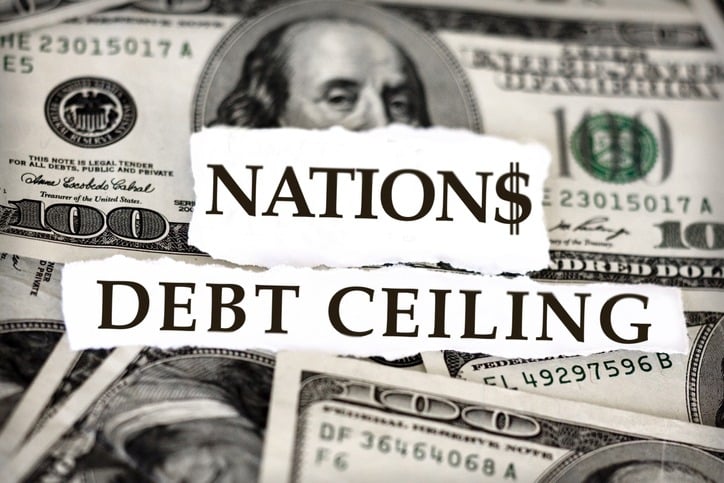The Debt Ceiling & You

What is the debt ceiling?
The debt ceiling is the amount of money the U.S. Department of the Treasury is authorized to borrow to pay the nation’s bills.
Those obligations include Social Security and Medicare benefits, tax refunds, military salaries and interest payments on outstanding national debt, for example.
The current ceiling is about $31.4 trillion. The U.S. hit that borrowing limit in January.
The debt ceiling wouldn’t be an issue if U.S. revenues — i.e., tax proceeds — exceeded its costs. But the U.S. hasn’t run an annual surplus since 2001 — and has borrowed to fund government operations each year since then, according to the White House Council of Economic Advisers.
The debt ceiling is an important policy tool for governments to ensure fiscal discipline and control over their borrowing. It is intended to prevent excessive debt accumulation and encourage responsible fiscal management. By imposing a limit on borrowing, governments are forced to evaluate and prioritize their spending decisions.
The debt ceiling and federal debt have grown under both political parties.

If the debt ceiling binds, and the U.S. Treasury does not have the ability to pay its obligations, the negative economic effects would quickly mount and risk triggering a deep recession.
Now, the economy is coming off its worst inflationary cycle since the early 1980s and the 10-year is yielding around 3.5%, but that is down significantly in recent weeks. At the same time, the Fed is raising interest rates to their highest levels in years and also reducing its own holding of government securities. Markets have been volatile, and many economists are predicting a recession – even if only a mild one – sometime this year.
On top of that, investors and those saving for their retirements have already seen major damage done to their IRAs and 401(k)s over the past year as the Fed has tightened monetary policy.
Here are some of the ways it could affect consumers and investors:
1. Frozen federal benefits
If the federal government doesn’t have enough cash on hand to pay its bills, the most likely scenario is one in which it prioritizes making debt payments to bondholders — meaning other recipients of federal funds would get a late payment.
That would affect tens of millions of American households, who wouldn’t get certain federal benefits — such as Social Security, Medicare and Medicaid, and federal aid related to nutrition, veterans and housing — on time.
Initially, payments may come a day or so late — but the delay would lengthen the longer a deal isn’t reached.
2. A recession, with job cuts
In that scenario, households would have less cash on hand to pump into the U.S. economy — and a recession “would seem to be inevitable” under these circumstances.
A default, or even the threat of one, would weigh on financial markets and erode confidence among consumers, investors and businesses, causing a pullback in spending and hiring, and that chaos would impact the U.S. economy.
The U.S. would shed 500,000 jobs and the national unemployment rate would increase by 0.3 percentage point in the third quarter of 2023 if there’s a short default, the CEA estimated. Those numbers balloon in a longer debt crisis — to over 8 million lost jobs and a five-point spike in unemployment.
3. Higher borrowing costs
Investors generally view U.S. Treasury bonds and the U.S. dollar as safe havens. Bondholders are confident the U.S. will give their money back with interest on time.
It’s revered in the U.S. financial system that U.S. Treasury debt is risk free.
If that’s no longer the case, ratings agencies would likely downgrade the country’s top-grade credit rating, and investors will demand much higher interest rates on Treasury bonds to compensate for the additional risk.
Borrowing costs would rise for American consumers, since rates on mortgages, credit cards, auto loans and other types of consumer debt are linked to movements in the U.S. Treasury market. Businesses would also pay higher interest rates on their loans.
4. Extreme stock market volatility
Of course, that’s assuming businesses and consumers could get credit. There might also be a severe financial crisis if the U.S. government is unable to issue additional Treasury bonds, which are an essential component of the financial system.
A default would send shock waves through global financial markets and would likely cause credit markets worldwide to freeze up and stock markets to plunge.
Even the threat of a default during the 2011 debt-ceiling crisis caused Standard & Poor’s (now known as S&P Global Ratings) to downgrade the credit rating of U.S. and generated considerable market gyrations.
The S&P 500 fell nearly 17% between July 22 and Aug. 8 during the debt-ceiling impasse in 2011, which was “perhaps the closest brush the United States has had” with default, according to a note published by Wells Fargo Economics.
The CEA estimates the stock market would plunge by 45% in the third quarter in a protracted default.
5. Other ways the debt ceiling can have implications for individuals and the broader economy:
Government Operations: If the debt ceiling is not raised or suspended in a timely manner, the government may face a potential default on its obligations. This can disrupt government operations, including the payment of salaries to government employees, funding for programs and services, and payments to contractors.
Economic Confidence: The debt ceiling debate can erode public confidence in the economy and government's ability to manage its finances effectively. This loss of confidence can have a detrimental effect on consumer and business sentiment, potentially leading to reduced spending, investment, and economic growth.
It's worth noting that the specific implications of the debt ceiling can vary depending on economic and political circumstances. The above points generally outline the potential effects, but the precise impact on individuals can differ based on the specific policies and actions taken by the government in response to the debt ceiling constraints.
Let’s get back to basics – shouldn’t the gov’t be doing the same?
- Budgeting
- Priorities
- Debt Management
- Wise investments
- Accountability
Well, we have to plan and protect ourselves accordingly, we cannot rely on the government or others to do it for us.
The use of guaranteed protections and income and volatility shields is imperative.
Contact me at [email protected]
Check out our website at www.retirewisepro.com
#RetireHappy #retirementplanning #Financial Planning

Retirement Planning






